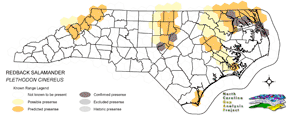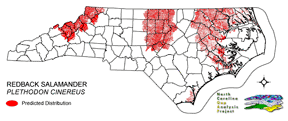
| Taxa: |
| Order: |
| Family: |
| Amphibia |
| Caudata |
| Plethodontidae |
| NatureServe Global Rank: |
| NatureServe State (NC) Rank: |
| G5 |
| S5 |
| Federal Status: |
| NC State Status: |
| --- |
| --- |


| Land Unit |
| US Fish & Wildlife Service |
| US Forest Service |
| US National Park Service |
| US Department of Defense |
| NC State Parks |
| NC University System |
| NC Wildlife Res. Com. |
| NC Forest Service |
| NC Div. of Coastal Mgmt. |
| Local Governments |
| Non-Governmental Org. |
| Other Public Lands |
| Private Lands |
| GAP Status 1-2 |
| All Protected Lands |
| Statewide |
| Hectares |
| 1,271.25 |
| 93,958.65 |
| 3,768.12 |
| 6,707.07 |
| 8,701.47 |
| 1,032.66 |
| 21,351.33 |
| 726.30 |
| 405.36 |
| 6,151.95 |
| 5,426.19 |
| 1,937.07 |
| 1,599,996.33 |
| 41,113.08 |
| 150,763.14 |
| 1,751,433.75 |
| Acres |
| 3,141.33 |
| 232,176.84 |
| 9,311.23 |
| 16,573.53 |
| 21,501.80 |
| 2,551.76 |
| 52,760.28 |
| 1,794.73 |
| 1,001.67 |
| 15,201.80 |
| 13,408.40 |
| 4,786.60 |
| 3,953,676.26 |
| 101,592.61 |
| 372,543.76 |
| 4,327,886.21 |
| % of Dist. on |
| Prot. Lands |
| 0.8 % |
| 62.3 % |
| 2.2 % |
| 4.4 % |
| 5.8 % |
| 0.7 % |
| 14.2 % |
| 0.5 % |
| 0.3 % |
| 3.6 % |
| 3.6 % |
| 1.2 % |
| 0.0 % |
| 27.3 % |
| ----- |
| ----- |
| % of Dist. on |
| All Lands |
| < 0.1 % |
| 5.4 % |
| 0.2 % |
| 0.4 % |
| 0.5 % |
| < 0.1 % |
| 1.2 % |
| < 0.1 % |
| < 0.1 % |
| 0.4 % |
| 0.3 % |
| 0.1 % |
| 91.4 % |
| 2.3 % |
| ----- |
| ----- |
|
In North Carolina, the redback salamander is found in the northern and eastern mountains, and in northern sections of the lower piedmont and coastal plain (Martof et al. 1980). An isolated population occurs in the southern coastal plain along the Cape Fear river. This species lives in well-shaded forest settings, with mesic, well-drained soils (Wilson 1995, Petranka 1998). It uses damp ground cover or microhabitat situations on the floor of conifer, deciduous or mixed forests (Wilson 1995, Petranka 1998). High abundances have been found in mature forests with deep, well-drained non-acidic soils (Petranka 1998). Avoids seeps, springs or other wet areas (Wilson 1995). NATURE SERVE GLOBAL HABITAT COMMENTS: Damp microhabitats in wooded areas; inside logs, under leaf litter, or under surface objects during day. Goes underground during freezing or hot, dry weather. In New York, tended to be absent where soil pH was less than 3.8; much more abundant in beech forest than in hemlock forest (Wyman 1988, Wyman and Jancola 1992, Frisbie and Wyman 1992). Lays eggs in cavity in log or stump or under rock or other objects on ground. |
| Code | Name | Description | NC Natural Heritage Program Equivalent |
| 121 | Maritime Pinelands | Loblolly forests and woodlands of the outer coastal plain. | Estuarine Fringe Loblolly Pine Forest |
| 17 | Maritime Forests and Hammocks | Maritime forests and woodlands dominated by live or sand laurel oak. Estuarine Fringe forests dominated by loblolly pine. | Coastal Fringe Evergreen Forest, Maritime Deciduous Forest, Maritime Deciduous Forest |
| 63 | Coastal Plain Mesic Hardwood Forests | Beech dominated forests with white oak and northern red oak as possible co-dominants. Dry-mesic to mesic forests on slopes and small stream bottoms in the coastal plain. | Mesic Mixed Hardwood Forest, Basic Mesic Forests |
| 138 | Coastal Plain Dry to Dry-Mesic Oak Forests | Oak dominated forests of the coastal plain. Includes white oak forests with water oak or northern red oak and hickories as co-dominants. | Dry Mesic Oak Hickory Forest, Basic Oak Hickory Forest, Dry Oak Hickory Forest |
| 97 | Mesic Longleaf Pine | Longleaf pine woodlands without a major scrub oak component. Slash or loblolly pines may be present as well. | Mesic Pine Flatwoods |
| 230 | Piedmont Mesic Forest | American Beech - Red Oak - White Oak Forests. | Mesic Mixed Hardwood |
| 383 | Piedmont Mixed Successional Forest | Generally loblolly mixed with successional hardwoods. Sweetgum, tulip poplar and red maple are common co-dominants in these successional forests. | No equivalent |
| 228 | Piedmont Dry-Mesic Oak and Hardwood Forests | Primarily oak dominated forests, white oak is often dominant, with co-dominants including . Also represented by sweetgum and tulip poplar dominated forests. | Dry Mesic Oak Hickory Forest, Basic Oak Hickory Forest, Dry Oak Hickory Forest |
| 222 | Piedmont Dry-Mesic Pine Forests | Loblolly dominated forests resulting from succession following clearing. This type occurs on all moisture regimes following disturbance with the exception of the extremely xeric sites. | No equivalent |
| 382 | Dry Mesic Oak Pine Forests | Mixed forests of the coastal plain and piedmont. Includes loblolly pine with white, southern red and/or post oak and loblolly with water oak. On basic sites of the piedmont, eastern red cedar may co-occur with post, black, and blackjack oaks. | Dry Mesic Oak Hickory Forest, Xeric Hard Pan Forest, Chestnut Oak Forest, Dry Mesic Oak Hickory Forest, Dry Oak Hickory Forest |
| 21 | Coniferous Cultivated Plantation (natural / planted) | Managed pine plantations, densely planted. Most planted stands are loblolly, but slash and longleaf occur as well. | No equivalent |
| 51 | Deciduous Cultivated Plantation | Planted deciduous trees. Includes sweetgum and sycamore plantations. | No equivalent |
| 36 | Successional Deciduous Forests | Regenerating deciduous trees with a shrub stature. Commonly dominated by sweetgum, tulip poplars and maples. | No equivalent |
| 522 | Northern Hardwoods | High Elevation forests including yellow birch, American beech, and yellow buckeye. Includes forests with Hemlock and Yellow Birch. | Northern Hardwoods Forest, Boulderfield Forest |
| 525 | Appalachian Oak Forest | A variety of oak forest types including Black, White, Scarlet Oaks in dry to mesic situations. Includes forests historically co-dominated by American Chestnut. | High Elevation Red Oak Forest, Montane White Oak Forest |
| 526 | Appalachian Cove Forest | Mixed Mesophytic forests of the mountains. Includes tuliptree, basswood, yellow buckeye and surgar maple. This class is mapped to include cove forests dominated or co-dominated by hemlock. | Rich Cove Forest, Acidic Cove Forest |
| 527 | Appalachian Hemlock | Upland hemlock forests of the moutains region. Vary from side slopes to steep slope positions. | Canada Hemlock Forest |
|
Frisbie, M. P., and R. L. Wyman. 1992. The effect of soil chemistry on sodium balance in the red-backed salamander; a comparison of two forest types. J. Herpetol. 26:434-442.
Wyman, R. L., and J. Jancola. 1992. Degree and scale of terrestrial acidification and amphibian community structure. J. Herpetol. 26:392-401. Wilson, L. A. 1995. The Land Manager's Guide to the amphibians and reptiles of the South. Chapel Hill, NC: The Nature Conservancy. Wyman, R. L. 1988. Soil acidity and moisture and the distribution of amphibians in five forests of southcentral New York. Copeia 1988:394-399. Petranka, J. W. 1998. Salamanders of the United States and Canada. Washington DC: Smithsonian Inst. Press. Smith, P. W. 1963. PLETHODON CINEREUS. Cat. Am. Amph. Rep. 5.1-5.3. Minton, S. A., Jr. 1972. Amphibians and reptiles of Indiana. Indiana Academy Science Monographs 3. v + 346 pp. Behler, J. L., and F. W. King. 1979. The Audubon Society field guide to North American reptiles and amphibians. Alfred A. Knopf, New York. 719 pp. Martof, B. S., W. M. Palmer, J. R. Bailey, and J. R. Harrison, III. 1980. Amphibians and reptiles of the Carolinas and Virginia. University of North Carolina Press, Chapel Hill, North Carolina. 264 pp. Vogt, R. G. 1981. Natural history of amphibians and reptiles of Wisconsin. Milwaukee Public Museum. 205 pp. DeGraaf, R. M., and D. D. Rudis. 1983. Amphibians and reptiles of New England. Habitats and natural history. Univ. Massachusetts Press. vii + 83 pp. Green, N. B., and T. K. Pauley. 1987. Amphibians and reptiles in West Virginia. University of Pittsburg Press, Pittsburg, Pennsylvania. xi + 241 pp. |
For more information please contact them at:
NC-GAP Analysis Project
Dept. of Zoology, NCSU
Campus Box 7617
Raleigh, NC 27695-7617
(919) 513-2853
www.basic.ncsu.edu/ncgap